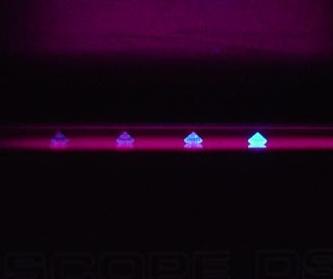Fluorescence in Diamonds: What It Is and How It Affects Your Diamond
Fluorescence in diamonds refers to the glow that a diamond emits when exposed to ultraviolet (UV) light. When a diamond has fluorescence, it can show a blueish glow (or, in rare cases, other colours) under UV light. This phenomenon is due to the presence of trace elements, typically boron or nitrogen, in the diamond’s crystal structure.
How Fluorescence Works in Diamonds
Ultraviolet Light Exposure:
Fluorescence occurs when a diamond is exposed to UV light—such as sunlight, certain types of lamps, or black lights—which excites the molecules in the diamond and causes them to emit visible light in a blue hue.
Intensity of Fluorescence:
The level of fluorescence can range from none to very strong. This is graded as follows:
None: No fluorescence under UV light.
Faint: The diamond shows a very slight fluorescence.
Medium: Noticeable fluorescence, but not very strong.
Strong: The diamond emits a noticeable glow when exposed to UV light.
Very Strong: The diamond gives off an intense glow in UV light.
Color of Fluorescence:
Most diamonds with fluorescence exhibit a blue glow, but in rare cases, the fluorescence can be yellow, green, or white. Blue fluorescence is the most common and generally considered desirable, as it can complement the diamond’s appearance and enhance its overall sparkle.
Fluorescence and Diamond Appearance
Visible Effects in Regular Lighting:
In general, fluorescence is not visible under normal lighting conditions. The glow only appears when the diamond is exposed to UV light. In everyday settings, such as under natural sunlight or incandescent lighting, fluorescence typically does not affect how the diamond looks.
Fluorescence and the Diamond’s Color:
Fluorescence can sometimes impact the appearance of a diamond’s color:
For diamonds with lower color grades (like K, L, or M), the blue fluorescence can give the diamond a whiter or brighter appearance, somewhat masking yellowish or brownish hues.
However, for higher color diamonds (like D, E, or F), fluorescence may cause the diamond to look duller or less bright, as the blue glow can contrast with the diamond’s natural whiteness.
Fluorescence and Diamond Clarity:
Fluorescence does not affect the clarity of a diamond, but it can sometimes make inclusions more visible in strongly fluorescent diamonds, especially under UV light. In extreme cases, fluorescence can make inclusions appear milky or cloudy, reducing the overall aesthetic.
Pros and Cons of Fluorescence in Diamonds
Pros:
Can Enhance Appearance for Lower Color Diamonds:
Blue fluorescence can make diamonds with lower color grades appear whiter or more colorless, which may be an advantage for buyers on a budget.
Increased Value for Some:
Some buyers find fluorescence desirable, especially when it gives the diamond an extra glow. It may also be perceived as a sign of rarity and uniqueness.
Unique Visual Effect:
Under UV light, the blue glow of a fluorescent diamond can create a unique visual effect that makes the diamond stand out.
Cons:
Potential for Reduced Value:
In some cases, diamonds with strong fluorescence may be valued less than those with no fluorescence, particularly in high-color diamonds, where the blue glow might interfere with the diamond’s natural brilliance.
Possible Cloudiness:
Strong fluorescence, especially in diamonds with a low clarity grade or inclusions, can cause the diamond to appear cloudy or milky in appearance under certain lighting conditions.
Not Always Desired:
Some buyers prefer diamonds without fluorescence because it can introduce a blueish tint that does not appeal to everyone. People who prefer the purest white diamonds may shy away from fluorescent stones.
Fluorescence in Diamond Grading
GIA Grading:
The GIA (Gemological Institute of America) grades fluorescence on a scale of None, Faint, Medium, Strong, and Very Strong.
GIA’s grading report will include the fluorescence grade, so potential buyers can make an informed decision.
Fluorescence vs. Other Factors:
Fluorescence is just one of many factors in determining a diamond’s value. While it can influence the overall appearance, it does not affect the diamond’s cut, carat weight, or clarity.
How Fluorescence Affects Diamond Pricing
Fluorescent Diamonds Can Be Less Expensive:
Generally, diamonds with strong fluorescence may be priced lower than diamonds with no fluorescence, especially if the fluorescence causes visible cloudiness or makes the diamond appear less brilliant in normal lighting.
Fluorescence Can Add Character:
However, some buyers appreciate the added glow and distinctiveness of fluorescent diamonds, and the blue fluorescence can actually increase the diamond’s appeal. The rarity of strong fluorescence in diamonds can sometimes be a selling point, adding value for certain collectors.
